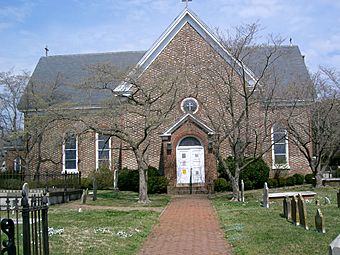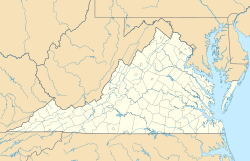St. John's Episcopal Church (Hampton, Virginia) facts for kids
|
St. John's Episcopal Church
|
|

Looking North at St. John's Episcopal Church
|
|
| Location | Northwest corner of W. Queen and Court Sts., Hampton, Virginia |
|---|---|
| Area | 9.9 acres (4.0 ha) |
| Built | 1728/1610 |
| Architect | Henry Cary Jr. |
| Architectural style | Georgian with Flemish bond brickwork |
| NRHP reference No. | 70000871 |
Quick facts for kids Significant dates |
|
| Added to NRHP | February 26, 1970 |
St. John's is an Episcopal church located in Hampton, Virginia. It is the oldest English-speaking church in America that has been active without stopping since it was founded. The church was started in 1610 and is part of the Episcopal Diocese of Southern Virginia.
The History of St. John's Church
English settlers from Jamestown created a community and church on the tip of the Virginia Peninsula. This happened on July 9, 1610. This was just one month after Lord De La Warr arrived at Jamestown with important supplies. These supplies helped end a very difficult time called the Starving Time in Jamestown. The new settlement was named after the Algonquian-speaking Kecoughtan people who lived there.
First Church Location: 1610–1623
Experts believe the first church was in the Church Creek area of Hampton. This is near where LaSalle and Chesapeake Avenues are today. Digs at the second church site have found old post holes. These show where the first church building might have stood.
The first minister of this new church was Reverend William Mease. He was chosen by the Bishop of London to lead the church in Kecoughtan. A historical marker on LaSalle Avenue shows the general area of this first church.
Second Church Location: 1623–1667
In 1619, the settlement was renamed Elizabeth Cittie. By 1623, the town had moved east of the Hampton River. Here, the second church for "Elizabeth City" parish was built. This site is now part of the Hampton University grounds.
The second church was left empty in 1667 after a third church was built. Its old foundations were found in 1910. It was a small wooden building, and a front room was added later. Today, you can see the original foundations and some brick floor. There are also paintings and a historical marker. Items found during the digging are on display at the St. John's Parish House museum.
Third Church Location: 1667–1728
The third church building was constructed more than a mile west of the second church. It was in an area called "Westwoods Town Quarter." This shows that the town was growing on the west side of the Hampton River. Like the church before it, this one was made of wood and was about the same size. This building was used for about 60 years.
This site is located off West Pembroke Avenue, east of LaSalle Avenue. It has a historical marker and building foundations outlined by bricks. You can also see several gravestones from the 1600s and 1700s. A protective brick wall surrounds the area.
Fourth Church Location: 1728–Present Day
In the early 1700s, the town's main activities were around the busy port, which is now downtown Hampton. The church members asked the Governor if they could move their church closer to where most people lived. Their request was approved.
Construction of the fourth church began on about one and a half acres on the edge of Hampton. Henry Cary Jr. from Williamsburg finished the current cross-shaped building in 1728. A bell tower was added to the west side in 1762. The building was damaged during the Revolutionary War and the War of 1812. It was most heavily damaged during the Civil War. It took the church many years to fix the damage after the War of 1812.
After being fully repaired, Bishop Richard Channing Moore officially named the church St. John's on March 6, 1830. The building was damaged again during the Civil War on August 7, 1861. Confederate soldiers set fire to homes, businesses, and the church. They did this to try and stop the town from being taken over by the Union army. The large bell was destroyed, and only the burned walls remained. Union soldiers then took over the town and camped in the churchyard.
Because of this fire, St. John's is the only colonial building still standing in downtown Hampton. After the war, money was collected from many people to help rebuild the church. The repairs were finished around 1869 or 1870. The outside of the church looked colonial again, but the inside showed the style of the late 1800s. In the early 1900s, a tower was added to the back. A west gallery was built in 1957, and a chapel was finished in 1985. The current organ was put in place in 1993.
Interesting Things to See
The Communion silver used today dates back to 1618. It has been used continuously longer than any other English church silver in America. These pieces were brought from England in 1619. They were first used in a church founded in 1618 in Smith's Hundred in Virginia. This area was between the Chickahominy and James Rivers, about eight miles northwest of Jamestown.
That church was almost completely destroyed during the Indian Massacre of March 22, 1622. The silver was then taken by Governor George Yeardley to Jamestown. Around 1628, it was given to the second Elizabeth City Church, which had just been built. St. John's still uses this communion silver for special events.
The chalice (a cup) has a London date-letter for 1618-1619. It also says: "THE COMMVNION CVPP FOR SNT MARYS CHVRCH IN SMITHS HVNDRED IN VIRGINIA". There are two patens (small plates) with the same date. The first paten says: "Whosoever shall eate this bread and drinke the cupp of the Lord/unworthily shalbe gilty of the body & blood of ye Lord Cor Ixith". The second paten says: "If any man eate of this Bread he shall live for ever Jo VIth".
In 1887, Native American students from the Hampton Normal and Agricultural Institute (now Hampton University) helped pay for a stained glass window. This window shows the baptism of Pocahontas.
On the chapel wall, to the left of the main altar, is an aumbry. This is a small cupboard. Its door panel has pieces of stained glass from the 1200s. These pieces came from St. Helena Church in Willoughby, Lincolnshire, United Kingdom. This was the church where Captain John Smith was baptized. The panel was given to St. John's Parish on July 14, 1985. This was part of St. John's 375th anniversary celebration.
Churches Started by St. John's
St. John's helped start several other churches. Each of these eventually became its own parish church.
St. Paul's Episcopal Church (Newport News, VA)
- Started in 1894 in Newport News. It supported families and workers in the shipbuilding and transportation industries. On July 20, 2019, the church building was no longer used for religious services.
Emmanuel Episcopal Church (Hampton, VA)
- Started on April 11, 1897, to support the growing community of Phoebus (Hampton).
St. Cyprian's Episcopal Church (Hampton, VA)
- Started in 1905 in Hampton, VA. This was the first all-black Episcopal church. It supported people in Hampton and Phoebus, students at Hampton University, and people in Newport News.
Grace Episcopal Church (Newport News, VA)
- Started in 1942 in Newport News. This church later left the US Episcopal Church. It joined the Anglican Mission in the Americas as River's Cross Anglican Church in 2004. River's Cross may have stopped meeting in late 2014. Their website and Facebook page are no longer available.
St. Mark's Episcopal Church (Hampton, VA)
- Started in 1963 as a mission of St. John's, Hampton. It served the growing population in northwestern Hampton. On July 25, 2019, the church building was no longer used for religious services. The St. Mark's church members now meet at St. John's Episcopal Church in Hampton.



